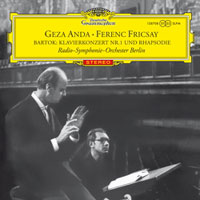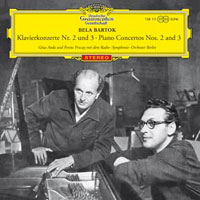Bartók • Concerto for Piano and Orchestra No. 1, Rhapsody for Piano and Orchestra, Op. 1
Bartók • Concertos for Piano and Orchestra Nos. 2 and 3
éla Bartók’s three piano concertos are the product of a mature composer in the last twenty years of his life. In 1904, when he wrote the Rhapsody for Piano and Orchestra (the B-side on the First Piano Concerto album), Bartók’s discovery of his own musical voice and tonal language lay before him. The Rhapsody is pre-Bartók Bartók. Its inclusion fills out the album while highlighting the composer’s compositional evolution exemplified by the First Piano Concerto. The Rhapsody features big chords with lengthy arpeggios that yield thick textures, and frankly it could use fewer notes to say what it does. By the time Bartók wrote his First Concerto for Piano in 1926, he had passed through several such efforts at a late-Romantic style and was now firmly entrenched in the world of atonality and dissonance that was 20th-century modernism. Adopting a musical language that was atonal -- a word telling us only what the music is not -- Bartók found the freedom to compose with his own unique logic while integrating his abiding interest in Hungarian and Romanian folk music. Dissonant interpretations of Bartók’s Magyar musical heritage infuse each of his piano concertos. The chords, harmonies and phrases developed over centuries of Western musical tradition set listeners expectations for melody, completion, and release. By contrast, Bartók’s modernist piano concertos emphasize motoric irregular rhythms, counterpoint, accents and stresses with lots of dynamic contrast. These operate inside dissonant nucleic themes that offer little sense of journey, destination or narrative. Bartók’s orchestrations feature percussion, brass and woodwinds, while relying on strings for texture and atmosphere. Each piano piece includes instances of Bartók’s famous "night music," a sound portrayal he often used in slower movements. Instead of harmony and melodic development, Bartók delivered his interpretations of nocturnal sounds from animals and insects, often using drum and cymbal taps, strikes and splashes. The meaning of these concertos always seems just around the corner, just out of reach. Nonetheless, for those willing to explore, each work offers wonder, obvious genius, and a celebration of the sheer physicality of sound. The score for the First Piano Concerto sets the percussion section at the front of the orchestra, surrounding the piano; the recording makes this obvious. Piano and timpani establish a throbbing low-register beat at the outset that continues to pulse in the listener’s head even when it takes a respite. An early anonymous reviewer said this: "The piano becomes a machine, the orchestra a machine workshop, and all in the service of brutal, crudely materialistic music." Here is Bartók’s dissonant interpretation of a feral Hungarian dance. With quirky rhythms and timing changes, the First Concerto technically is very difficult for pianist and orchestra alike. Some say its first hearing is equally difficult and early audiences received it poorly. Accepting this, Bartók wrote his Second Piano Concerto in 1930-31 partly to contrast with the First and partly to explain and exonerate it. The Second is lean, quick and stylistically more sophisticated while embracing the same piano-timpani pairing and propulsive forward movement as the First. With its greater sense of possible joy, the Second was popular. I found new understanding and appreciation relistening to the First after hearing the Second; they contrast as a dark-primitive/light-cosmopolitan pair. Bartók lay dying as he wrote his Third Piano Concerto in 1945. Despite its angular themes and spiky rhythms, the Third is the least obdurate and most accessible of the three. Its otherworldly but harmonically heartwarming Adagio religioso offers a striking contrast with Bartók’s music up to that point. Here is the final resting place of the composer’s evolution. Having both albums in hand makes obvious the progression of Bartók’s modernist genius. They say it takes a Hungarian to play one. On both albums, pianist Géza Anda and conductor Ferenc Fricsay offer an ideal pairing. Concertos sometimes suffer as a struggle between soloist and the conductor’s collective, but not here. Fricsay was a student of Bartók, and he and Anda had a lifelong affinity with the music of their countryman. Anda is a true virtuoso with near flawless technique. He offers a perfect blend of austerity and passion, tackling the works with total authority without bravura. Fricsay is naturally at home with Bartók’s rhythms, which require exactitude of timing. With absolutely seamless precision, Fricsay synchronizes accents and swift dynamic changes to deliver each whole intact. From the late 1950s to 1966, Deutsche Grammophon used album-cover stickers and then the Red Stereo imprint to highlight recordings as stereophonic. Today these are indicators to collectors that the albums so marked are more likely to have better sound than the sometimes thin and overly mic’d productions issued in the ‘70s and ‘80s. Speakers Corner created these two albums directly from
the DGG master tapes stored in Germany. Lacquers were cut at the Emile Berliner Studios in
Berlin. Speakers Corner notes that no EQ was necessary and what the listener hears is one
to one with the original tape. Although I sensed a very wee bit of up-tilt across the
board, that did nothing to detract from these monumental performances. I heard the piano
as closely mic’d, emphasizing its “hammers on strings” percussive
character, yet its sound was nicely integrated with other percussion instruments and the
orchestra overall. The recordings made obvious the onstage layout of the orchestral
sections and the overall acoustic environment. Both albums were free of defects and
surface noise. |


